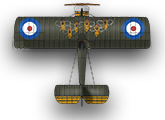Introduction
Background
I was reading “Fire in the Sky” when I came to this paragraph.
“The point is that the air war over the Western Front and Middle East was not about dogfights and aces. The RFC’s raison d’etre was characterised by the work of the humble two-seaters, chugging back and forth along the front lines for hours at a time snapping photographs or communicating with the artillery. It was unglamorous work, but absolutely crucial to the war’s successful conduct. The scout squadrons existed to protect them and destroy the enemy’s artillery and photo reconnaissance machines. In this sense, the war in the air between 1914 and 1918 was essentially a desperate struggle to get an uninterrupted view of the enemy’s affairs – its defences, gun emplacements and troop dispositions. When dogfights occurred, as they certainly did on an increasingly larger scale throughout the war, it was a natural consequence of this, and this only. Of course, the role of aircraft evolved as the war went on, coming to include ground attack, strategic bombing and even battlefield resupply. But the pilot’s core role from the beginning to the end of the war remained as ‘the eyes of the army’. The upshot of this was that the flying corps’ work was vital stuff that was inextricably linked to the success or failure of operations on the ground. It also meant that, for the pilots of this comparatively small component in the vastness of the British Army, there was always plenty of flying to be done.”
[Molkentin, Michael, Fire in the Sky; the Australian Flying Corps in the First World War,
Allen & Unwin, Crows Nest (NSW), 2010, p.39]
This prompted me to choose a scenario centring on ‘the humble two-seaters’ of the Entente.
Scenario
Playing area:
3 WoG playing mats with the trench map in the centre.
Aircraft:
This combination is based on the dates the planes were mostly flown, according to the French chart. See the dates in brackets. WoG damage points or WoG values were not taken into account.
Entente – Sopwith 1˝ Strutter, escorted by Airco DH2 [Jul16-Apr 17; Feb 16-Feb 17]
Central Powers – 2x Halbestadt D.III [Jul-Oct 16]
Outline:
The Entente two-seater is conducting a reconnaissance mission to identify German troop activities and placements.
The Central Powers are set on disrupting this activity to make it unsuccessful.
Victory conditions:
Entente: two-seater gets home safely with at least 3 photographs.
Central Powers: prevent the two-seater from fulfilling its mission by either a) preventing it from taking 3 photographs; b) shooting it down; or c) blocking the two-seater from getting home.
Rules for play:
The two-seater must photograph as many parts of the German line as it can. Once it has taken a photograph, a camera token will be left on that position. (‘Targets’ for photographing are not marked beforehand, because this gives the Central Powers players an unfair advantage.)
The two-seater must announce that it is taking a photograph, and then perform the manoeuvre. “To photograph the target, the [two-seater] must perform a stall manoeuvre … starting it when its centre is at half ruler distance from any point on the target card. The photograph can not be taken any more if the observer is incapacitated.” (Wings of War; duels between famous aces in the skies of the First World War, Nexus, Calderara di Reno, 2008, p.7)
If the two-seater is receiving gun fire, then it cannot take a photograph. The plane would be too unstable, and the observer may be required to fire at the attacking plane.
After taking a photograph, the two-seater must play two manoeuvres before it can take another one to give the observer time to remove the exposed plate, store it, and place a new plate in the camera ready for another photograph.





 Reply With Quote
Reply With Quote























Bookmarks